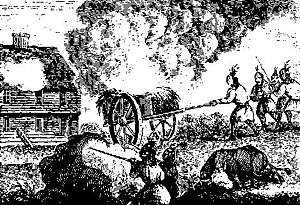King Philip's War
King Philip's War (sometimes called the First Indian War, Metacom's War, Metacomet's War, Pometacomet's Rebellion, or Metacom's Rebellion)[2] was an armed conflict in 1675–1678 between indigenous inhabitants of New England and New England colonists and their indigenous allies. The war is named for Metacomet, the Wampanoag chief who adopted the name Philip because of the friendly relations between his father Massasoit and the Mayflower Pilgrims.[3] The war continued in the most northern reaches of New England until the signing of the Treaty of Casco Bay in April 1678.[4]
Massasoit had maintained a long-standing alliance with the colonists. Metacom (c. 1638–1676) was his younger son, and he became tribal chief in 1662 after Massasoit's death. Metacom, however, did not maintain his father's alliance between the Wampanoags and the colonists. The colonists insisted that the peace agreement in 1671 should include the surrender of Indian guns; then three Wampanoags were hanged for murder in Plymouth Colony in 1675 which increased the tensions. Indian raiding parties attacked homesteads and villages throughout Massachusetts, Rhode Island, Connecticut, and Maine over the next six months, and the Colonial militia retaliated. The Narragansetts remained neutral, but several individual Narragansetts participated in raids of colonial strongholds and militia, so colonial leaders deemed them to be in violation of peace treaties. The colonies assembled the largest army that New England had yet mustered, consisting of 1,000 militia and 150 Indian allies, and Governor Josiah Winslow marshaled them to attack the Narragansetts in November 1675. They attacked and burned Indian villages throughout Rhode Island territory, culminating with the attack on the Narragansetts' main fort in the Great Swamp Fight. An estimated 600 Narragansetts were killed, and the Indian coalition was then taken over by Narragansett sachem Canonchet. They pushed back the colonial frontier in Massachusetts Bay, Plymouth, and Rhode Island colonies, burning towns as they went, including Providence in March 1676. However, the colonial militia overwhelmed the Indian coalition and, by the end of the war, the Wampanoags and their Narragansett allies were almost completely destroyed.[5] On August 12, 1676, Metacom fled to Mount Hope where he was killed by the militia.
The war was the greatest calamity in seventeenth-century New England and is considered by many to be the deadliest war in Colonial American history.[6] In the space of little more than a year, 12 of the region's towns were destroyed and many more were damaged, the economy of Plymouth and Rhode Island Colonies was all but ruined and their population was decimated, losing one-tenth of all men available for military service.[7]:656[8] More than half of New England's towns were attacked by Indians.[9]
King Philip's War began the development of an independent American identity. The New England colonists faced their enemies without support from any outside government or military, and this began to give them a group identity separate and distinct from Britain.[10]
Historical context
Plymouth Colony was established in 1620 with significant early help from local Indians, particularly Squanto and Massasoit. Subsequent colonists founded Salem, Boston, and many small towns around Massachusetts Bay between 1628 and 1640, during a time of increased English immigration. The colonists progressively expanded throughout the territories of the several Algonquian-speaking tribes in the region. Prior to King Philip's War, tensions fluctuated between Indian tribes and the colonists, but relations were generally peaceful.[6]
The Rhode Island, Plymouth, Massachusetts Bay, Connecticut, and New Haven colonies each developed separate relations with the Wampanoags, Nipmucks, Narragansetts, Mohegans, Pequots, and other tribes of New England, whose territories historically had differing boundaries. Many of the neighboring tribes had been traditional competitors and enemies. As the colonial population increased, the New Englanders expanded their settlements along the region's coastal plain and up the Connecticut River valley. By 1675, they had established a few small towns in the interior between Boston and the Connecticut River settlements.
The Wampanoag tribe under Metacomet's leadership had entered into an agreement with the Plymouth Colony and believed that they could rely on the colony for protection. However, in the decades preceding the war, it became clear to them that the treaty did not mean that the Colonists were not allowed to settle in new territories.[6]
Failure of diplomacy
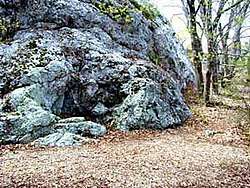
Metacomet became sachem of the Pokanoket and Grand Sachem of the Wampanoag Confederacy in 1662 after the death of his older brother Grand Sachem Wamsutta (called "Alexander" by the colonists), who had succeeded their father Massasoit (d. 1661) as chief. Metacomet was well known to the colonists before his ascension as paramount chief to the Wampanoags, but he distrusted the colonists.
The Plymouth colonists had passed laws making it illegal to have commerce with the Wampanoags. They learned that Wamsutta had sold a parcel of land to Roger Williams, so Governor Josiah Winslow had Wamsutta arrested, even though Wampanoags who lived outside of colonist jurisdiction were not accountable to Plymouth Colony laws. Metacomet began negotiating with the other Algonquian tribes against the Plymouth Colony soon after the death of his father and his brother.[11]
Population
The population of New England colonists totaled about 65,000 people.[12] They lived in 110 towns, of which 64 were in the Massachusetts Bay colony, which then included the southwestern portion of Maine. The towns had about 16,000 men of military age who were almost all part of the militia, as universal training was prevalent in all colonial New England towns. Many towns had built strong garrison houses for defense, and others had stockades enclosing most of the houses. All of these were strengthened as the war progressed. Some poorly populated towns were abandoned if they did not have enough men to defend them.
Each town had local militias based on all eligible men who had to supply their own arms. Only those who were too old, too young, disabled, or clergy were excused from military service. The militias were usually only minimally trained and initially did relatively poorly against the warring Indians, until more effective training and tactics could be devised. Joint forces of militia volunteers and volunteer Indian allies were found to be the most effective. The Indian allies of the colonists numbered about 1,000 from the Mohegans and Praying Indians, with about 200 warriors.[13]
By 1676, the regional Indian population had decreased to about 10,000 (exact numbers are unavailable), largely because of epidemics. These included about 4,000 Narragansetts of western Rhode Island and eastern Connecticut, 2,400 Nipmucks of central and western Massachusetts, and 2,400 combined in the Massachusett and Pawtucket tribes living around Massachusetts Bay and extending northwest to Maine. The Wampanoags and Pokanokets of Plymouth and eastern Rhode Island are thought to have numbered fewer than 1,000. About one in four were considered to be warriors. By then, the Indians had almost universally adopted steel knives, tomahawks, and flintlock muskets as their weapons. The various tribes had no common government. They had distinct cultures and often warred among themselves,[14] although they all spoke related languages from the Algonquian family.
The trial
John Sassamon was an Indian convert to Christianity, commonly referred to as a "praying Indian." He played a key role as a "cultural mediator," negotiating with both colonists and Indians while belonging to neither party.[15] He was an early graduate of Harvard College and served as a translator and adviser to Metacomet. He reported to the governor of Plymouth Colony that Metacomet planned to gather allies for Indian attacks on widely dispersed colonial settlements.[16]:221
Metacomet was brought before a public court, where court officials admitted that they had no proof but warned that they would confiscate Wampanoag land and guns if they had any further reports that he was conspiring to start a war. Not long after, Sassamon's body was found in the ice-covered Assawompset Pond, and Plymouth Colony officials arrested three Wampanoags on the testimony of an Indian witness, including one of Metacomet's counselors. A jury that included six Indian elders convicted the men of Sassamon's murder, and they were executed by hanging on June 8, 1675 (O.S.), at Plymouth.
Southern theater, 1675
Raid on Swansea
A band of Pokanokets attacked several isolated homesteads in the small Plymouth colony settlement of Swansea on June 20, 1675.[17] They laid siege to the town, then destroyed it five days later and killed several more people. On June 27, 1675, a full eclipse of the moon occurred in the New England area,[18] and various tribes in New England thought it a good omen for attacking the colonists.[19] Officials from the Plymouth and Massachusetts Bay colonies responded quickly to the attacks on Swansea; on June 28, they sent a punitive military expedition that destroyed the Wampanoag town at Mount Hope in Bristol, Rhode Island.
The war quickly spread and soon involved the Podunk and Nipmuck tribes. During the summer of 1675, the Indians attacked at Middleborough and Dartmouth, Massachusetts (July 8), Mendon, Massachusetts (July 14), Brookfield, Massachusetts (August 2), and Lancaster, Massachusetts (August 9). In early September, they attacked Deerfield, Hadley, and Northfield, Massachusetts.
Siege of Brookfield
Wheeler's Surprise and the ensuing Siege of Brookfield were fought in August 1675 between Nipmuc Indians under Muttawmp and the colonists of Massachusetts Bay under the command of Thomas Wheeler and Captain Edward Hutchinson.[20] The battle consisted of an initial ambush on August 2, 1675, by the Nipmucs against Wheeler's unsuspecting party. Eight men from Wheeler's company died during the ambush: Zechariah Phillips of Boston, Timothy Farlow of Billerica, Edward Coleborn of Chelmsford, Samuel Smedly of Concord, Shadrach Hapgood of Sudbury, Sergeant Eyres, Sergeant Prichard, and Corporal Coy of Brookfield.[21] Following the ambush was an attack on Brookfield, Massachusetts, and the consequent besieging of the remains of the colonial force. The Nipmuc forces harried the settlers for two days, until they were driven off by a newly arrived force of colonial soldiers under the command of Major Simon Willard.[22] The siege took place at Ayers' Garrison in West Brookfield, but the location of the initial ambush was a subject of extensive controversy among historians in the late nineteenth century.[23]
The New England Confederation comprised the Massachusetts Bay Colony, Plymouth Colony, New Haven Colony, and Connecticut Colony; they declared war on the Indians on September 9, 1675. The Colony of Rhode Island and Providence Plantations tried to remain neutral, but much of the war was fought on Rhode Island soil; Providence and Warwick suffered extensive damage from the Indians.
The next colonial expedition was to recover crops from abandoned fields along the Connecticut River for the coming winter and included almost 100 farmers and militia, plus teamsters to drive the wagons.
Battle of Bloody Brook
The Battle of Bloody Brook was fought on September 12, 1675, between militia from the Massachusetts Bay Colony and a band of Indians led by Nipmuc sachem Muttawmp. The Indians ambushed colonists escorting a train of wagons carrying the harvest from Deerfield to Hadley. They killed at least 40 militia men and 17 teamsters out of a company that included 79 militia.[24]
Attack on Springfield
The Indians next attacked Springfield, Massachusetts, on October 5, 1675, the Connecticut River's largest settlement at the time. They burned to the ground nearly all of Springfield's buildings, including the town's grist mill. Most of the Springfielders who escaped unharmed took cover at the house of Miles Morgan, a resident who had constructed one of the settlement's few fortified blockhouses.[25] An Indian servant who worked for Morgan managed to escape and alerted the Massachusetts Bay troops under the command of Major Samuel Appleton, who broke through to Springfield and drove off the attackers.
Morgan's sons were famous Indian fighters in the territory. His son Peletiah was killed by Indians in 1675. Springfielders later honored Miles Morgan with a large statue in Court Square.[25]
The Great Swamp Fight
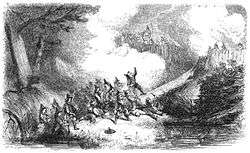
On November 2, Plymouth Colony governor Josiah Winslow led a combined force of colonial militia against the Narragansett tribe. The Narragansetts had not been directly involved in the war, but they had sheltered many of the Wampanoag fighters, women, and children. Some of their warriors had participated in several Indian attacks. The colonists distrusted the tribe and did not understand the various alliances. As the colonial forces went through Rhode Island, they found and burned several Indian towns which had been abandoned by the Narragansetts, who had retreated to a massive fort in a frozen swamp. The cold weather in December froze the swamp so that it was relatively easy to traverse. The colonial force found the Narragansett fort on December 19, 1675, near present-day South Kingstown, Rhode Island; they attacked in a combined force of Plymouth, Massachusetts, and Connecticut militia numbering about 1,000 men, including about 150 Pequots and Mohican Indian allies. The fierce battle that followed is known as the Great Swamp Fight. It is believed that the militia killed about 600 Narragansetts. They burned the fort (occupying over 5 acres (20,000 m2) of land) and destroyed most of the tribe's winter stores.
Most of the Narragansett warriors escaped into the frozen swamp. The colonists lost many of their officers in this assault; about 70 of their men were killed and nearly 150 more wounded. The rest of the colonial assembled forces returned to their homes, lacking supplies for an extended campaign. The nearby towns in Rhode Island provided care for the wounded until they could return to their homes.[26]
Mohawk intervention
In December 1675, Metacomet established a winter camp in Schaghticoke, New York.[27] His reason for moving into New York has been attributed to a desire to enlist Mohawk aid in the conflict.[28] Though New York was a non-belligerent, Governor Edmund Andros was nonetheless concerned at the arrival of the Wampanoag sachem.[27] Either with Andros' sanction, or of their own accord, the Mohawk—traditional rivals of the Algonquian people—launched a surprise assault against a 500-warrior band under Metacomet's command the following February.[27][28] The "ruthless" coup de main resulted in the death of between 70 and as many as 460 of the Wampanoag.[29][27] His forces crippled, Metacomet withdrew to New England, pursued "relentlessly" by Mohawk forces who attacked Algonquian settlements and ambushed their supply parties.[27][30][29]
Over the next several months, fear of Mohawk attack led some Wampanoag to surrender to the colonists, and one historian described the decision of the Mohawk to engage Metacomet's forces as "the blow that lost the war for Philip".[28][27]
Indian campaign
Indians attacked and destroyed more settlements throughout the winter of 1675–76 in their effort to annihilate the colonists. Attacks were made at Andover, Bridgewater, Chelmsford, Groton, Lancaster, Marlborough, Medfield, Medford, Portland, Providence, Rehoboth, Scituate, Seekonk, Simsbury, Sudbury, Suffield, Warwick, Weymouth, and Wrentham, including modern-day Norfolk and Plainville. The famous account written and published by Mary Rowlandson after the war gives a colonial captive's perspective on the conflict.[31]
Southern theater, 1676
Lancaster raid
The Lancaster raid in February 1676 was an Indian attack on the community of Lancaster, Massachusetts. Philip led a force of 1,500 Wampanoag, Nipmuc, and Narragansett Indians in a dawn attack on the isolated village, which then included all or part of the neighboring modern communities of Bolton and Clinton. They attacked five fortified houses. The house of the Rev. Joseph Rowlandson was set on fire, and most of its occupants were slaughtered—more than 30 people. Rowlandson's wife Mary was taken prisoner, and afterward wrote a best-selling captivity narrative of her experiences. Many of the community's other houses were destroyed before the Indians retreated northward.
Plymouth Plantation Campaign
.jpg)
The spring of 1676 marked the high point for the combined tribes when they attacked Plymouth Plantation on March 12. The town withstood the assault, but the Indians had demonstrated their ability to penetrate deep into colonial territory. They attacked three more settlements; Longmeadow (near Springfield), Marlborough, and Simsbury were attacked two weeks later. They killed Captain Pierce[32] and a company of Massachusetts soldiers between Pawtucket and the Blackstone's settlement. Several colonial men were tortured and buried at Nine Men's Misery in Cumberland as part of the Indians' ritual torture of enemies. They also burned the settlement of Providence to the ground on March 29. At the same time, a small band of Indians infiltrated and burned part of Springfield while the militia was away.
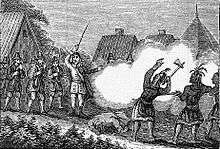
The settlements within the modern-day state of Rhode Island became a literal island colony for a time as the settlements at Providence and Warwick were sacked and burned, and the residents were driven to Newport and Portsmouth on Rhode Island. The Connecticut River towns had thousands of acres of cultivated crop land known as the bread basket of New England, but they had to limit their plantings and work in large armed groups for self-protection.[33]:20 Towns such as Springfield, Hatfield, Hadley, and Northampton, Massachusetts, fortified themselves, reinforced their militias, and held their ground, though attacked several times. The small towns of Northfield, Deerfield, and several others were abandoned as the surviving settlers retreated to the larger towns. The towns of the Connecticut colony were largely unharmed in the war, although more than 100 Connecticut militia died in their support of the other colonies.
Attack on Sudbury
The Attack on Sudbury was fought in Sudbury, Massachusetts, on April 21, 1676. The town was surprised by Indian raiders at dawn, who besieged a local garrison house and burned several unoccupied houses and farms. Reinforcements that arrived from nearby towns were drawn into ambushes by the Indians; Captain Samuel Wadsworth lost his life and half of a 70-man militia in such an ambush.
Battle of Turner's Falls
On May 18, 1676, Captain William Turner of the Massachusetts Militia and a group of about 150 militia volunteers (mostly minimally trained farmers) attacked an Indian fishing camp at Peskeopscut on the Connecticut River, now called Turners Falls, Massachusetts. The colonists killed 100–200 Indians in retaliation for earlier Indian attacks against Deerfield and other settlements and for the colonial losses in the Battle of Bloody Brook. Turner and nearly 40 of the militia were killed during the return from the falls.[34]
The colonists defeated an attack at Hadley on June 12, 1676 with the help of their Mohegan allies, scattering most of the Indian survivors into New Hampshire and farther north. Later that month, a force of 250 Indians was routed near Marlborough, Massachusetts. Combined forces of colonial volunteers and their Indian allies continued to attack, kill, capture, or disperse bands of Narragansetts, Nipmucs, and Wampanoags as they tried to plant crops or return to their traditional locations. The colonists granted amnesty to those who surrendered or who were captured and showed that they had not participated in the conflict. Captives who had participated in attacks on the many settlements were hanged, enslaved, or put to indentured servitude, depending upon the colony involved.
Battle of Mount Hope
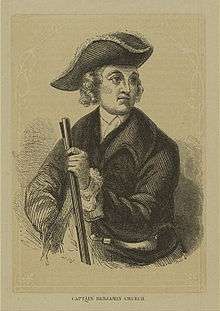
Metacomet's allies began to desert him, and more than 400 had surrendered to the colonists by early July. Metacomet took refuge in the Assowamset Swamp below Providence, and the colonists formed raiding parties of militia and Indian allies. Metacomet was killed by one of these teams when he was tracked down by Captain Benjamin Church and Captain Josiah Standish of the Plymouth Colony militia at Mount Hope in Bristol, Rhode Island. He was shot and killed by an Indian named John Alderman on August 12, 1676.[7]:647 Metacomet's corpse was beheaded, then drawn and quartered, a traditional treatment of criminals in this time period. His head was displayed in Plymouth for a generation.[35]
Captain Church and his soldiers captured Pocasset war chief Anawan on August 28, 1676, at Anawan Rock in Rehoboth, Massachusetts. He was an old man at the time, and a chief captain of Metacomet. His capture marked the final event in King Philip's War, as he was also beheaded.
Northern Theater (Maine and Acadia)
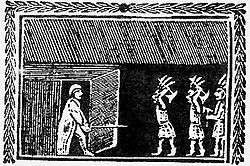
Before the outbreak of war, English settlers in Maine and New Hampshire lived peaceably with their Wabanaki neighbors. Colonists engaged in fishing, harvesting timber, and trade with Indians. By 1657 English towns and trading posts stretched along the coast eastward to the Kennebec River. These communities were scattered and lacked fortifications. The defenseless posture of English settlements reflected the amicable relationship between Wabanakis and colonists to that time.[36]
Upon hearing news of the Wampanoag attack on Swansea, colonists in York marched up the Kennebec River in June 1675 and demanded that Wabanakis turn over their guns and ammunition as a sign of goodwill. Apart from being an affront to their sovereignty, Natives depended on their guns to hunt. After handing over some of their weapons, many Wabanakis starved the following winter. English colonists exacerbated tensions by shooting at Penobscots in Casco Bay and drowning the infant son of Pequawket sagamore Squando. Impelled by hunger and English violence, Wabanakis began raiding trading posts and attacking settlers.[37]
Under the leadership of Androscoggin sagamore Mogg Hegon and Penobscot sagamore Madockawando, Wabanakis annihilated English presence east of the Saco River. Three major campaigns (one each year) were launched by the Indians in 1675, 1676, and 1677, most of which led to a massive colonial response. Richard Waldron and Charles Frost led the English colonial forces in the northern region. Waldron sent forces that attacked the Mi'kmaq in Acadia.
Throughout the campaigns, Mogg Hegon repeatedly attacked towns such as Black Point (Scarborough), Wells, and Damariscove, building an Indian navy out of the approximately 40 sloops and a dozen 30-ton ships previously armed by militia. Maine's fishing industry was completely destroyed by the Wabanaki flotilla. Records from Salem record 20 ketches stolen and destroyed in one raid in Maine.[38]
Colonial responses to Wabanaki attacks generally failed in both their objectives and accomplishments. Likely upon learning that Mohawks had agreed to enter the war on New England's side, Wabanakis sued for peace in 1677. The official fighting ended in the northern theater with the Treaty of Casco (1678). The treaty allowed English settlers to return to Maine and acknowledged Wabanaki triumph in the conflict by requiring each English family to pay Wabanakis a peck of corn each year as tribute.[39]
By the end of the war, the Northern Campaigns saw approximately 400 settlers die, Maine's fishing economy eviscerated, and the Indians maintaining power in eastern and northern Maine. There is not an accurate account of the number of Indians who died, but it is thought to be between 100 and 300.[38]
Aftermath
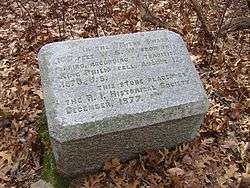
Southern New England
The war in southern New England largely ended with Metacomet's death. More than 1,000 colonists and 3,000 Indians had died.[1] More than half of all New England towns were attacked by Indian warriors, and many were completely destroyed.[9] Several Indians were enslaved and transported to Bermuda, including Metacomet's son, and numerous Bermudians today claim ancestry from the Indian exiles. Members of the sachem's extended family were placed among colonists in Rhode Island and eastern Connecticut. Other survivors joined western and northern tribes and refugee communities as captives or tribal members. Some of the Indian refugees returned to southern New England.[40] The Narragansetts, Wampanoags, Podunks, Nipmucks, and several smaller bands were virtually eliminated as organized bands, and even the Mohegans were greatly weakened.
The Colony of Rhode Island was devastated by the war, as its principal city Providence was destroyed. Nevertheless, the Rhode Island legislature issued a formal rebuke to Connecticut Governor John Winthrop on October 26, scarcely six months after the burning of the city—although Winthrop had died. The "official letter" places blame squarely on the United Colonies of New England for causing the war by provoking the Narragansetts.[41]
Sir Edmund Andros had been appointed governor of New York in 1674 by the Duke of York, who claimed that his authority extended as far north as Maine's northern boundary. He negotiated a treaty with some of the northern Indian bands in Maine on April 12, 1678. Metacomet's Pennacook allies had made a separate peace with the colonists as the result of early battles that are sometimes identified as part of King Philip's War. The tribe nevertheless lost members and eventually its identity as the result of the war.[42]
Plymouth Colony
Plymouth Colony lost close to eight percent of its adult male population and a smaller percentage of women and children to Indian warfare or other causes associated with the war.[16]:332 Indian losses were much greater, with about 2,000 men killed or who died of injuries in the war, more than 3,000 dying of sickness or starvation, and another 1,000 Indians sold into slavery and transported to other areas, such as the British-controlled islands in the Caribbean. About 2,000 Indians escaped to other tribes to the north or west; they joined continued Indian attacks from those bases well into the next century. Historians estimate that, as a result of King Philip's War, the Indian population of southern New England was reduced by about 40 to 80 percent.
Northern New England
In northern New England, conflict continued for decades in Maine, New Hampshire, and northern Massachusetts. Wabanakis gradually entered the French orbit as English incursions on their territory continued.[43] There were six wars over the next 74 years between New France and New England, along with their respective Indian allies, starting with King William's War in 1689. (See the French and Indian Wars, Father Rale's War, and Father Le Loutre's War.) The conflict in northern New England was largely over the border between New England and Acadia, which New France defined as the Kennebec River in southern Maine.[44][45][46] Many colonists from northeastern Maine and Massachusetts temporarily relocated to larger towns in Massachusetts and New Hampshire to avoid Wabanaki raids.[4]
See also
References
- "King Philip's War". Retrieved January 8, 2016.
- Faludi, Susan (September 7, 2007). "America's Guardian Myths". The New York Times. Retrieved September 6, 2007.
- Lepore, Jill (1998). The Name of War: King Philip's War and the Origins of American Identity. New York: Alfred A. Knopf.
- Norton, Mary Beth. In the Devil's Snare: The Salem Witchcraft Crisis of 1692, New York: Vintage Books, 2003
- King Philip's War at the Encyclopædia Britannica
- Drake, James David (1999). King Philip's War: Civil War in New England, 1675-1676. The University of Massachusetts Press. pp. 1–15. ISBN 1558492240.
- Gould, Philip (Winter 1996). "Reinventing Benjamin Church: Virtue, Citizenship and the History of King Philip's War in Early National America". Journal of the Early Republic. 16. doi:10.2307/3124421.
- Schultz, Eric B.; Michael J. Touglas (2000). King Philip's War: The History and Legacy of America's Forgotten Conflict. W.W. Norton & Co. argues that 600 out of the about 80,000 colonists (1.5%) and 3,000 out of 10,000 Indians (30%) lost their lives in the war.
- "1675-King Philip's War". Society of Colonial Wars in the State of Connecticut. 2011. Retrieved January 8, 2016.
- Lepore (1998), The Name of War (1999) pp 5-7
- George Howe, Mount Hope (1958) ISBN 0670490814
- Historical Statistics of the United States: Colonial Times to 1970 (PDF) (Report). 1975. Retrieved July 8, 2020.
- Exact numbers of Indian allies are unavailable but about 200 warriors are mentioned in different dispatches implying a total population of about 800-1,000.
- Herbert L. Osgood, The American Colonies in the Seventeenth Century (1904) 1: 543
- Lepore p. 10.
- Philbrick, Nathaniel (2006). Mayflower: A Story of Courage, Community, and War. New York: Penguin.
- Church, Benjamin (1639-1718). "The History of King Philip's War". HathiTrust. Retrieved August 12, 2015.
- Moon Eclipse calculation Accessed December 22, 2011
- Leach, Douglas Edward; Flintlock and Tomahawk; p. 46; Parnassus Imprints, East Orleans, Massachusetts; 1954; ISBN 0-940160-55-2
- Schultz and Tougias, pg. 147
- Captain Thomas Wheeler's Narrative, p. 4: https://archive.org/stream/captainthomaswhe00whee#page/4/mode/2up/search/smedly.
- Peirce, Ebenezer Weaver (1878). Indian History, Biography and Genealogy: Pertaining to the Good Sachem Massasoit of the Wampanoag Tribe, and His Descendants. North Abington, Mass.: Zerviah Gould Mitchell.
- Schultz and Tougias, pg. 151
- Schultz, Eric; Tougias, Michael (1999). King Philip's War. Woodstock, VT: The Countryman Press.
- "Miles Morgan". Retrieved August 12, 2015.
- Leach (1954), Flintlock and Tomahawk, pp. 130–132
- Tougias, Michael (2017). King Philip's War: The History and Legacy of America's Forgotten Conflict. Countryman Press. ISBN 1581574908.
- Drake, James (1999). King Philip's War: Civil War in New England, 1675-1676. University of Massachusetts Press. p. 122. ISBN 1558492240.
- Barr, Daniel (2006). Unconquered: The Iroquois League at War in Colonial America. Greenwood. p. 73. ISBN 0275984664.
- Calloway, Colin (2000). After King Philip's War: Presence and Persistence in Indian New England. University Press of New England. ISBN 1611680611.
- The Narrative of the Captivity and the Restoration of Mrs. Mary Rowlandson (1682), City University of New York
- "Capt Michael Pierce's Defeat (1615 - 1676) - Find a Grave Memorial". Retrieved August 12, 2015.
- Phelps, Noah Amherst (1845). History of Simsbury, Granby, and Canton; from 1642 to 1845. Hartford: Press of Case, Tiffany and Burnham.
- Leach, Douglas Edward, Flintlock and Tomahawk – New England in King Philip's War, pp. 200–203
- Schultz, Eric and Michael Tougias. King Philip's War: The History and Legacy of America's Forgotten Conflict". The Countryman Press. 1999. p. 290
- Edwin A. Churchill, “Mid-Seventeenth Century Maine: A World on the Edge” in Emerson W. Baker, Edwin A. Churchill, Richard S. D’Abate, Kristine L. Jones, Victor A. Konrad, and Harald E.L. Prins, eds. American Beginnings: Exploration, Culture, and Cartography in the Land of Norumbega (Lincoln: University of Nebraska Press, 1995), 242–45.
- Daniel R. Mandell, King Philip's War: Colonial Expansion, Native Resistance, and the End of Indian Sovereignty (Baltimore: Johns Hopkins University Press, 2010), 77-81; Documentary History of the State of Maine (Portland: Maine Historical Society), 6:177-80.
- Duncan, Roger F. Coastal Maine: A Maritime History. Woodstock: Countryman, 2002. Print.
- Mandell, King Philip's War, 133–34; Jeremy Belknap, The History of New-Hampshire (Philadelphia: Robert Aitken, 1784), 1:158–59
- Spady, James O'Neil (Summer 1995). "As if in a Great Darkness: Native American Refugees of the Middle Connecticut River Valley in the Aftermath of King Philip's War: 1677–1697". Historical Journal of Massachusetts. 23 (2): 183–97.
- Allen, Zachariah (April 10, 1876). Bi-centenary of the Burning of Providence in 1676: Defence of the Rhode Island System of Treatment of the Indians, and of Civil and Religious Liberty. An Address Delivered Before the Rhode Island Historical Society. Providence: Providence Press Company. pp. 11-12. Retrieved February 11, 2019.
providence burned 1676.
- "Seacoast NH History - Colonial Era - Cochecho Massacre". Archived from the original on January 14, 2010. Retrieved August 12, 2015.
- Prins, Harald E. L. (March 1999). "Storm Clouds over Wabanakiak: Confederacy Diplomacy Until Dummer's Treaty (1727)". The Atlantic Policy Congress of First Nations Chiefs. Passamaquoddy Tribe at Pleasant Point. Retrieved May 19, 2016.
- Williamson, William. The History of the State of Maine. Vol. 2. 1832. p. 27
- Griffiths, N.E.S. (2005). From Migrant to Acadian: A North American Border People, 1604-1755. McGill-Queen's University Press. p. 61. ISBN 978-0-7735-2699-0.
- Campbell, Gary. The Road to Canada: The Grand Communications Route from Saint John to Quebec. Goose Lane Editions and The New Brunswick Heritage Military Project. 2005. p. 21.
Bibliography
Primary sources
- Easton, John, A Relation of the Indian War, by Mr. Easton, of Rhode Island, 1675 (See link below.)
- Eliot, John, "Indian Dialogues": A Study in Cultural Interaction eds. James P. Rhonda and Henry W. Bowden (Greenwood Press, 1980).
- Mather, Increase, A Brief History of the Warr with the Indians in New-England (Boston, 1676; London, 1676).
- ---. Relation of the Troubles Which Have Happened in New England by Reason of the Indians There, from the Year 1614 to the Year 1675 (Kessinger Publishing, [1677] 2003).
- ---. The History of King Philip's War by the Rev. Increase Mather, D.D.; also, a history of the same war, by the Rev. Cotton Mather, D.D.; to which are added an introduction and notes, by Samuel G. Drake (Boston: Samuel G. Drake, 1862).
- ---. "Diary", March 1675–December 1676: Together with extracts from another diary by him, 1674–1687 /With introductions and notes, by Samuel A. Green (Cambridge, Massachusetts: J. Wilson, [1675–76] 1900).
- Rowlandson, Mary, The Sovereignty and Goodness of God: with Related Documents (Bedford/St. Martin's Press, 1997).
- Rowlandson, Mary, The Narrative of the Captivity and the Restoration of Mrs. Mary Rowlandson (1682) online edition
- "Edward Randolph, the Causes and Results of King Philip's War (1675)"; an early account of the war, available online.
Secondary sources
- Brooks, Lisa. 2019. Our Beloved Kin: A New History of King Philip's War. Yale University Press.
- Cave, Alfred A. The Pequot War (Amherst: University of Massachusetts Press, 1996).
- Cogley, Richard A. John Eliot's Mission to the Indians before King Philip's War (Cambridge, Massachusetts: Harvard University Press, 1999).
- Hall, David. Worlds of Wonder, Days of Judgment: Popular Religious Belief in Early New England (Cambridge, Massachusetts: Harvard University Press, 1990).
- Kawashima, Yasuhide. Igniting King Philip's War: The John Sassamon Murder Trial (Lawrence: University Press of Kansas, 2001).
- Leach, Douglas Edward, Flintlock and Tomahawk: New England in King Philip's War; Parnassus Imprints, East Orleans, Massachusetts; 1954; ISBN 0-940160-55-2
- Lepore, Jill. The Name of War: King Philip's War and the Origins of American Identity (New York: Vintage Books, 1999).
- Mandell, Daniel R. King Philip's War: Colonial Expansion, Native Resistance, and the End of Indian Sovereignty (Johns Hopkins University Press; 2010) 176 pages
- Norton, Mary Beth. "In the Devil's Snare: The Salem Witchcraft Crisis of 1692" (New York: Vintage Books, 2003)
- Philbrick, Nathaniel. Mayflower: A Story of Courage, Community, and War (Penguin USA, 2006) ISBN 0-670-03760-5
- Pulsipher, Jenny Hale. Subjects unto the Same King: Indians, English, and the Contest for Authority in Colonial New England (Philadelphia: University of Pennsylvania Press, 2005)
- Schultz, Eric B. and Michael J. Tougias, King Philip's War: The History and Legacy of America's Forgotten Conflict.' New York: W.W. Norton and Co., 2000.
- Slotkin, Richard and James K. Folsom. So Dreadful a Judgement: Puritan Responses to King Philip's War. (Middletown, CT: Weysleyan University Press, 1978) ISBN 0-8195-5027-2
- Vaughan, Alden T. New England Frontier: Puritans and Indians, 1620-1675 (1979)
- Warren, Jason W. Connecticut Unscathed: Victory in the Great Narragansett War, 1675–1676 (2014). excerpt
- Webb, Stephen Saunders. 1676: The End of American Independence (Syracuse, NY: Syracuse University Press, 1995).
- Zelner, Kyle F. A Rabble in Arms: Massachusetts Towns and Militiamen during King Philip's War (New York: New York University Press, 2009) excerpt and text search
Further reading
- DeLucia, Christine M. (2018). Memory Lands: King Philip's War and the Place of Violence in the Northeast. New London, Conn.: Yale University Press. ISBN 9780300201178. OCLC 982566405.
External links
| Wikimedia Commons has media related to King Philip's War. |
- Peters, Paula, "We Missed You", Cape Cod Times, July 14, 2002
- King Philip's War in Peirce, Ebenezer Weaver, Indian history, biography and genealogy: pertaining to the good sachem Massasoit of the Wampanoag tribe, and his descendants, Z.G. Mitchell, 1878
- Records of Lancaster, Massachusetts, p.324
